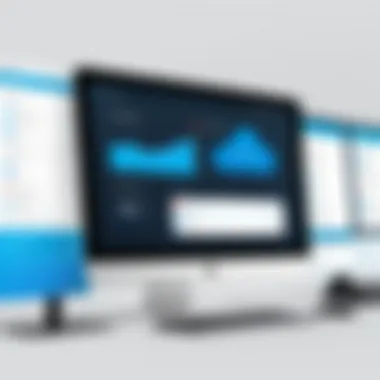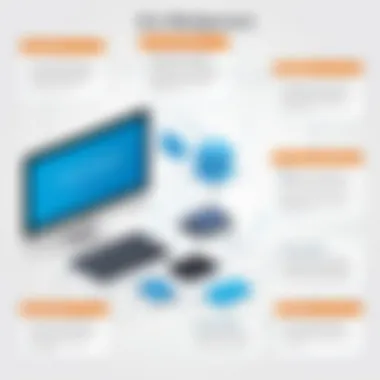Mastering Mass Email with Salesforce: A Comprehensive Guide


Intro
Sending mass emails has become an essential aspect of modern business communication. Many organizations rely on effective email marketing strategies to reach larger audiences. Salesforce, a leading customer relationship management (CRM) platform, offers tools that simplify this process. Utilizing Salesforce for mass emailing can enhance the efficiency of your communications while ensuring compliance with legal standards.
In this guide, we will examine various aspects of sending mass emails with Salesforce. From features and benefits to comparisons with alternatives, we aim to provide IT professionals and business leaders a comprehensive understanding of how to effectively engage audiences through email marketing. We will share the necessary preparations, explore key functionalities, and discuss best practices that lead to successful email campaigns.
Understanding the Need for Mass Email in Salesforce
In today’s fast-paced business environment, effective communication is paramount. Mass email allows organizations to send messages to a large audience simultaneously. This feature is particularly useful for companies using Salesforce, as it streamlines the communication process, reduces time spent on individual emails, and maintains a consistent message across the board.
Importance of Bulk Communication
Bulk communication serves several strategic purposes. First, it enables organizations to disseminate crucial information efficiently. Whether announcing new products, promotions, or changes within the organization, mass emails ensure that everyone receives the message at the same time. This level of cohesion is essential for maintaining brand consistency and fostering trust among clients and internal team members.
Furthermore, mass emails can significantly improve engagement rates. When a company sends a well-crafted bulk email to its audience, it reaches customers where they are most active — their inbox. This direct line of communication increases the likelihood of responses and interactions compared to other forms of marketing.
However, it is not only about sending a message. Understanding the recipients is vital. Segmenting your audience allows for more targeted messaging, which can lead to higher conversion rates. For example, a company can tailor content based on purchase history or demographic information, making each email feel personalized.
Contextual Uses in Business
The applications of mass emailing in a business context are numerous and diverse. Organizations can employ this strategy in various scenarios:
- Promotional Campaigns: Companies often use mass emails to announce sales or product launches. This ensures that the target audience is informed promptly, maximizing the promotional impact.
- Newsletters: Regular updates about company news, industry trends, and helpful tips can keep your audience engaged and informed. A well-maintained newsletter can enhance brand loyalty and trust.
- Event Invitations: Mass emails are ideal for inviting customers and stakeholders to events, webinars, or conferences, providing all necessary details in one communication.
- Surveys and Feedback Requests: Gathering feedback from clients can be streamlined with mass emailing. A collective request for responses can enhance data collection efficiency.
"Mass emails offer a streamlined way to communicate with a large audience, which can save time and enhance brand consistency."
In summary, understanding the importance of mass email within Salesforce allows businesses to optimize their communication strategies significantly. As organizations leverage this powerful tool, they can enhance engagement, maintain brand integrity, and ultimately drive better business outcomes.
Prerequisites for Sending Mass Emails
Before embarking on the journey of mass email communication through Salesforce, understanding the prerequisites is crucial. This foundational knowledge ensures a smoother process and helps prevent common pitfalls during email campaigns. Each requirement plays a significant role in maximizing the impact of your mass emails, whether for marketing or communication purposes within a business context.
Salesforce Account Configuration
The first step is ensuring that your Salesforce account is properly configured. This setup includes verifying that you have the right permissions to access mass email features. Usually, administrators control these settings, which may limit or enhance your ability to send out bulk communications. Understanding the difference between standard and enterprise editions of Salesforce can also provide insight into the capabilities available to you.
Key aspects to consider:
- User Permissions: Ensure your Salesforce role includes necessary permissions for mass emailing.
- Email Settings: Review the organization's email settings, confirming that your IP is not blacklisted.
- Integration Options: Consider whether you need additional tools or plugins, such as Pardot or Marketing Cloud, for advanced email capabilities.
Understanding Email Limits
Salesforce imposes specific limits on the number of emails sent in a day, which varies based on the type of account. This regulation is in place to promote responsible email sending and maintain platform integrity. Knowing these limits beforehand can save a lot of frustration later.
- Daily Limits: For standard editions, the limit may be as low as 500 emails per day. In contrast, enterprise versions may allow upwards of 5,000 or more.
- Hard and Soft Limits: Distinguish between hard limits (absolute maximums) and soft limits (guidelines that, if exceeded, may lead to restrictions).
- Sending Window: Be aware that the sending limit applies to a 24-hour period, and plan your campaigns accordingly to avoid interruptions.
Email Deliverability Considerations
To successfully reach your audience, it's important to address email deliverability. This involves various factors that influence whether your emails land in the inbox or end up in spam folders. A well-configured email strategy can significantly enhance deliverability rates, ensuring your messages are received as intended.
- Authentication Protocols: Set up SPF, DKIM, and DMARC for your domain. These protocols authenticate your emails and help prevent spoofing.
- Maintain a Clean List: Regularly clean your email list to remove inactive users and invalid addresses. High bounce rates can negatively impact your sender reputation.
- Content Quality: Focus on creating engaging and relevant content. Emails with poor-quality content are often marked as spam, hurting future deliverability.


"A good email strategy not only adheres to compliance but also fosters trust with your audience."
In summary, addressing these prerequisites is essential for effective mass email campaigns in Salesforce. Proper account configuration, awareness of email limits, and robust deliverability practices will equip you with the tools for success. Mastering these foundational elements will set the stage for impactful communications.
Setting Up Your Email Templates
Setting up email templates is a crucial phase in the mass email process within Salesforce. Well-designed templates not only enhance the aesthetic appeal of your communications but also boost the effectiveness of your email marketing efforts. Your email templates serve as the foundation for how recipients perceive your brand. A professional and engaging template can capture attention and foster engagement, which is vital in today’s competitive email landscape.
Creating Custom Email Templates
Custom email templates in Salesforce allow you to tailor your messages according to your audience's preferences. This flexibility can enhance your branding strategy and promote a stronger connection with the recipients. Companies can develop unique templates that align with their tone and style, making their communications more memorable.
When creating a custom template, consider the following aspects:
- Brand Identity: Ensure that your template reflects your brand’s colors, fonts, and logo. Consistency here builds trust.
- Responsive Design: Design should accommodate various devices. Many users check emails on mobile, making responsiveness non-negotiable.
- Clear Call-to-Action: Each email should guide recipients towards a specific action, so clarity in the CTA is important.
In Salesforce, custom templates can be created using the Lightning Email Templates or Classic Email Templates features. This aligns well with various communication goals, from newsletters to promotional offers.
Utilizing Pre-built Templates
Salesforce offers a variety of pre-built email templates that can significantly reduce the time and effort spent on design. These templates come with the requisite structure aimed at optimizing readability and engagement. While they might lack the unique touch of custom-designed emails, they provide a perfect starting point.
Utilizing pre-built templates means:
- Time Efficiency: Quick access to designs allows speed in creating and sending emails.
- Basic Compliance: Many templates include components that facilitate compliance with legal standards like the CAN-SPAM Act.
- Testing Options: Pre-built templates allow for testing various formats to gauge which resonates more with your audience.
Leveraging these templates can be particularly beneficial for businesses with limited design resources or for those aiming to streamline their communication workflow.
Personalization Techniques
Personalization is fundamental in achieving higher engagement rates in email marketing. In Salesforce, personalization techniques can transform a standard template into an effective communication tool. By embedding customer data directly into the body of the email, you can create a more engaging experience.
To incorporate personalization effectively, consider the following techniques:
- Dynamic Content: Use fields such as the recipient's name, company, and previous interactions to tailor email content.
- Segmentation: Segment your audience based on interests or behaviors to send more relevant messages. Salesforce allows detailed tracking to help with this.
- Behavioral Triggers: Setting up automated emails based on user behavior can increase the immediacy of your communications. For example, sending a follow-up email after a user clicks a link can prompt further action.
"Personalized emails deliver six times higher transactional rates."
This statistic emphasizes the significant impact that personalization can infuse into your email marketing efforts.
By setting up your email templates thoughtfully, whether through custom designs or pre-built formats, and employing personalization strategies, you can significantly enhance the effectiveness of your mass email campaigns. This foundation will lead to not only better engagement but also a stronger relationship with your audience.
Using Salesforce Mass Email Features
The ability to send mass emails is a key function for those using Salesforce. This not only enhances communication capabilities but also streamlines outreach efforts for businesses, irrespective of their size. The mass email features in this platform provide a systematic approach to engage with multiple recipients simultaneously, making the process efficient and effective. When managed properly, these features can drive engagement, improve marketing reach, and facilitate maintaining customer relationships.
Mass Email Wizard Overview
The Mass Email Wizard is a user-friendly tool that helps users in Salesforce to create and send bulk emails quickly. This feature is designed to simplify the process, allowing users to navigate easily through the various steps necessary to send mass emails. It includes a guided interface that prompts necessary actions, ensuring no crucial information is overlooked.
The wizard enables users to select templates, determine recipients, and schedule emails—all in an organized manner. Utilizing tools like the Mass Email Wizard can significantly reduce the time spent on email communication tasks, improving overall efficiency in email campaigns.
Selecting Recipients
Selecting the right recipients for your mass email is critical. It is not just about quantity but also about relevance. Salesforce provides various options to filter recipients based on criteria such as demographics, interests, or past interactions.


- Use contact lists to identify your target audience.
- Segment your audience to cater tailored messages for each group.
- Review past engagement metrics to inform your selection.
Making informed choices on recipients can enhance the effectiveness of your communication. Targeted messaging leads to higher engagement rates, which increases the return on investment for your email campaigns.
Scheduling Sends
Scheduling your sends appropriately is another important aspect of mass emailing in Salesforce. By determining the best times to send your emails, you can significantly boost open rates. Understanding audience behavior can guide these decisions.
- Utilize analytics from previous campaigns to identify peak engagement periods.
- Consider time zone differences when targeting an international audience.
- Test different sending times to refine your strategy over time.
"Strategically timing your email sends can be as crucial as the content itself."
This process, combined with Salesforce’s robust features, empowers users to tailor their outreach effectively, thus maximizing impact.
Compliance and Best Practices
When sending mass emails through Salesforce, adherence to compliance regulations and best practices is paramount. Understanding these elements not only helps to foster trust with your audience but also ensures your organization avoids substantial penalties associated with non-compliance. Furthermore, it boosts deliverability rates and optimizes overall email marketing efforts.
Compliance involves following set regulations such as the CAN-SPAM Act, which outlines the legal requirements for commercial email communications. Broken down, compliance ensures that recipients can identify the sender easily, understand the purpose of the email, and are provided mechanisms to opt out of future communications. Best practices include maintaining high-quality email lists, personalizing content, and respecting user preferences.
Incorporating these principles leads to improved response rates and limits the risk of landing in spam folders.
Understanding CAN-SPAM Act Requirements
The CAN-SPAM Act, introduced in 2003, sets guidelines for commercial email communication in the United States. Compliance with this act is essential for all organizations sending mass emails. Key provisions of the act are as follows:
- Truthful Subject Lines: Email subject lines should not be misleading. Clear and honest subject lines help recipients to understand the content at a glance.
- Sender Identification: Senders must provide a valid physical postal address within the email. This increases transparency and trust.
- Opt-Out Mechanisms: Every email must contain an opt-out option that allows recipients to unsubscribe from future emails easily.
- Timely Processing of Opt-Out Requests: An organization has ten business days to honor opt-out requests, ensuring that respect for user preferences is prioritized.
Understanding these requirements can safeguard your business against fines and strengthen relationships with customers.
Opt-Out Mechanisms
Opt-out mechanisms are critical elements of mass email compliance. They empower recipients to manage their email subscriptions according to their preferences. A robust opt-out system can significantly affect email marketing success, as it fosters goodwill among recipients. The best practices regarding opt-out mechanisms are:
- Prominently Display Options: Ensure the unsubscribe option is easy to find. Typically, this is placed at the bottom of the email.
- One-Click Unsubscribe: Opt for a simple one-click unsubscribe link. Complicated processes lead to frustration and resentment.
- Confirmation of Subscription Changes: When someone opts-out, consider sending a confirmation email. This shows that you respect their decision to unsubscribe.
- Respect Their Choice: Ensure that unsubscribed recipients are promptly removed from your mailing list.
Implementing these practices honors user preferences and can help maintain a positive brand reputation.
Privacy Considerations
When engaging in mass email campaigns, privacy must be a primary consideration. Protecting customer data not only complies with regulations but also builds consumer trust. Here are essential privacy considerations:
- Data Security: Ensure you have robust measures to protect recipient data from unauthorized access. Use encryption methods for data storage and transfer.
- Minimal Data Collection: Collect only the data necessary for your marketing objectives. Over-collection can lead to privacy concerns.
- Transparency: Be clear on how you will use any collected information. Providing a privacy policy is advisable.
- Business Accountability: Regularly audit your email practices to ensure compliance and data protection.
By maintaining a commitment to privacy, businesses can cultivate loyal customer relationships while minimizing risks associated with data breaches.
Monitoring and Analyzing Email Performance
Monitoring and analyzing email performance is a crucial step in the mass emailing process within Salesforce. This stage allows businesses to understand how their audience interacts with their emails, helping refine strategies for better engagement and conversion rates. By systematically tracking specific metrics, organizations can identify strengths and weaknesses in their email marketing efforts. This continuous feedback loop is essential for optimizing future campaigns and ensuring communication remains effective.
Key Metrics to Track
To ensure comprehensive analysis, there are certain key metrics that should be consistently monitored:


- Open Rate: This metric shows the percentage of recipients who opened the email. A low open rate may suggest issues with subject lines or timing.
- Click-through Rate (CTR): This indicates the percentage of readers who clicked on links within the email. It helps gauge the effectiveness of the content.
- Bounce Rate: This tells you how many emails could not be delivered. Understanding why emails bounce can help maintain a clean email list.
- Unsubscribe Rate: This metric tracks how many recipients opt out after receiving an email. High rates may indicate a mismatch between content and audience expectations.
- Conversion Rate: Finally, measuring how many recipients complete the desired action post-email (like making a purchase) is critical in evaluating overall campaign success.
"Without monitoring email performance, you are shooting arrows in the dark. Knowing your metrics illuminates the path forward."
Utilizing Salesforce Reports
Salesforce offers powerful reporting tools to support email performance analysis. These reports enable users to delve deep into metrics, offering insights that guide strategic decisions. Here's how to effectively utilize Salesforce Reports for analyzing email campaigns:
- Create Custom Reports: Tailor reports to focus specifically on mass email performance. Pull in metrics that are crucial for your analysis.
- Use Dashboards: Set up dashboards that provide at-a-glance views of email performance metrics. This visual representation can quickly highlight trends and issues.
- Schedule Regular Reviews: Establish a routine for reviewing email reports. Regular monitoring allows for timely adjustments to strategies, optimizing performance continually.
- Segment Analysis: Group reports by various segments such as demographics or engagement levels. Analyzing performance across different groups can uncover valuable insights.
Common Issues and Troubleshooting
Addressing common issues and troubleshooting effectively is a vital part of any mass email campaign using Salesforce. Despite the comprehensive features available, users often encounter challenges that can impede their communication efforts. Recognizing these issues ahead of time can save enterprises significant time and resources. Moreover, resolving these matters enhances both deliverability and user trust, leading to a more efficient email marketing strategy.
When sending mass emails, understanding the potential pitfalls can keep your communication running smoothly. This section will explore two significant challenges: email bounces and blocks, along with spam filter misunderstandings. Both of these areas are crucial to ensuring your email reaches your intended audience and operates within the optimal parameters of the system.
Email Bounces and Blocks
Email bounces occur when messages cannot be delivered to the recipient's inbox. There are two types of bounces: soft and hard. Soft bounces indicate a temporary issue, which might include a full inbox or a server error. Hard bounces signify a permanent delivery failure, often due to an incorrect email address. Addressing hard bounces promptly is crucial. You can clean your mailing list to maintain its integrity and avoid damaging sender reputation.
When dealing with bounces, consider these points:
- Regular List Maintenance: Keep your email list updated to reduce hard bounces.
- Return Path Analysis: Monitor the bounce back messages to understand the reasons behind failures and take corrective actions.
- Segmentation: Target engaged users more often than inactive ones.
In addition, blocked emails can occur due to the receiving server's configurations. This can be a result of flagged content or sender reputation issues. To mitigate blocking risks:
- Monitor bounce rates closely.
- Use tools such as Return Path to assess sender reputation.
- Respect unsubscribe requests to avoid being flagged as spam.
Understanding Spam Filters
Spam filters play a significant role in determining whether an email lands in the inbox or the junk folder. These filters evaluate multiple elements before deciding the fate of an email. From sender reputation to content analysis, various factors influence their decisions.
To navigate spam filters more effectively, consider the following elements:
- Content Quality: Avoid excessive promotional language and maintain a professional tone.
- Sender Authentication: Implement SPF, DKIM, and DMARC protocols for better deliverability.
- User Engagement: High engagement rates improve your sender score, reducing the chances of landing in spam.
- Feedback Loops: Enroll in feedback loops with major ISPs to understand user reactions.
"Taking proactive steps to manage your sending practices can significantly enhance email deliverability and performance."
By understanding and addressing these common issues, organizations can enhance their email marketing campaigns. Ensuring that your messages are received as intended is critical in maintaining effective communication with your audience. With thorough troubleshooting practices, you can safeguard your sender reputation and ultimately reach your business goals.
The End and Key Takeaways
Understanding the process of sending mass emails using Salesforce is essential for professionals looking to enhance their communication strategies. This section ties together the insights presented throughout the article, highlighting the importance of compliance, best practices, and performance monitoring. By focusing on these elements, businesses can optimize their email marketing efforts and improve customer engagement.
Summarizing the Process
In summary, sending mass emails with Salesforce involves several critical steps:
- Configuration: Ensure that your Salesforce account is set up correctly to utilize its mass email features effectively.
- Template Creation: Develop email templates that are customized and aligned with your brand message.
- Recipient Selection: Carefully choose your audience to target the right recipients based on their preferences and behaviors.
- Compliance: Familiarize yourself with legal requirements such as the CAN-SPAM Act and include necessary opt-out mechanisms.
- Monitoring: After sending emails, monitor performance metrics to understand the effectiveness of your campaigns.
Each of these steps is interrelated and plays a crucial role in the overall success of email campaigns. Following a structured approach helps in addressing potential issues effectively and ensuring communication efforts remain focused and impactful.
Final Recommendations
To conclude, here are a few recommendations for professionals aiming to use Salesforce for mass emailing:
- Leverage Personalization: Utilize personalization techniques to enhance engagement with your audience. Tailored emails tend to yield higher response rates.
- Test Before Sending: Conduct tests by sending emails to a small group before the full rollout. This strategy identifies potential errors and assesses compatibility with various email clients.
- Regularly Update Lists: Maintain accurate and updated contact lists. Frequent cleansing of your database ensures your communications reach the intended recipients.
- Analyze and Adjust: Be iterative in your approach. Analyze results and make necessary adjustments based on what the data reveals about subscriber behavior.
By following these recommendations, businesses can maximize the effectiveness of their mass email campaigns using Salesforce. The integration of proper practices not only enhances customer experience but also boosts overall marketing success.



